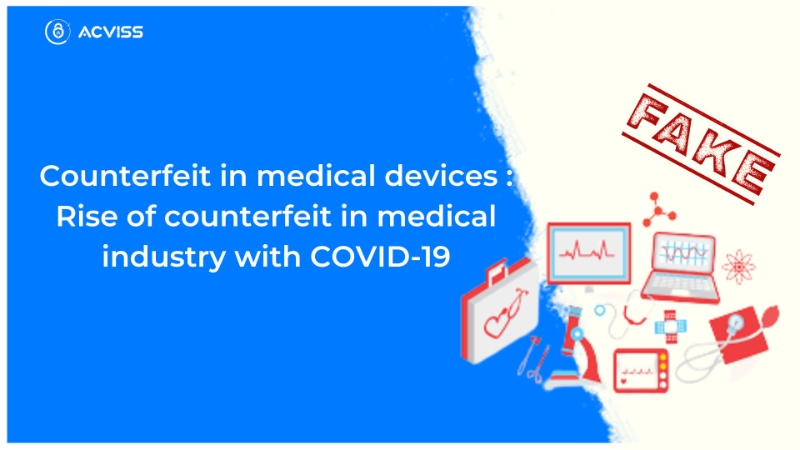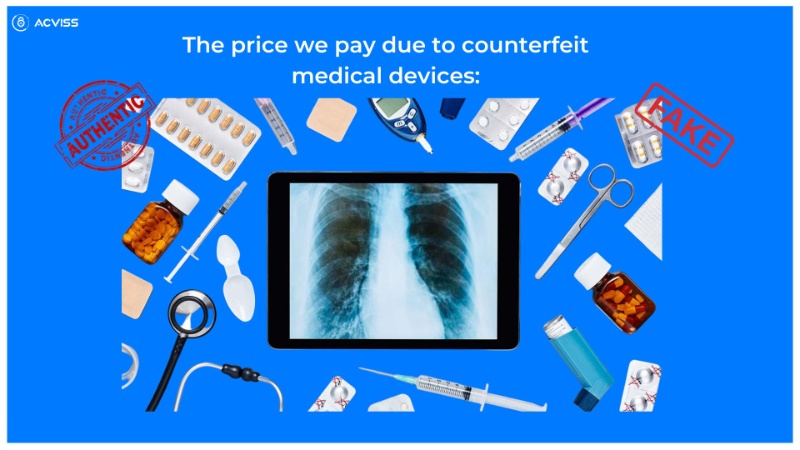What makes counterfeiting medical devices a green pasture for the grey market?

Fake medicines and immunity boosters have been a thorn in the pharmaceutical and healthcare sectors. Stringent regulations and surprise raids have exposed the size of the problem. Given the circumstances, the Indian government recently advised pharmaceutical companies to adopt serialization and integrate QR codes into their products. While the global supply chain and the COVID-19 pandemic continue to complicate the issue, we are missing a bigger problem. W all know that cure follows a correct diagnosis. Today, the healthcare sector relies on advanced technology and medical devices for diagnosis and treatment. Unfortunately, as we focus all our energy on the issue of fake medicines, counterfeit medical devices continue to thrive. We may be lucky if a counterfeit medical device does not function. But often, counterfeit medical devices can lead to more dangerous outcomes.
What happens if the life-saving respirator does not support a patient with collapsing lungs? Even expert doctors may assume that the patient is not responding to the respirator. Can you imagine the consequences of a faulty insulin pen? Even if the insulin is a genuine product, a faulty pen used daily can cause complications. Is it ok for a diabetic patient whose life depends on insulin to suffer from pain, skin rashes, and infections because of a fake pen? A person already struggling with a chronic health condition does not need the added pain!
When the numbers speak:
Timely medical care is a human right. Yet, there are 2 billion people worldwide with no access to basic healthcare. In such dire situations, the issue of fake medical devices becomes exacerbated. In 2010, a WHO report stated that 8% of the medical equipment and devices in the market are fake. However, the actual number can be much higher. Counterfeit healthcare products increased by 47% from 2020 to 2021. Reports predict that the growth rate for fake medical devices will be 5% every year till 2028. Experts warn that developing nations are at high risk of being victims of counterfeit medical devices.
What makes counterfeiting medical devices a green pasture for the grey market?
The pandemic and the shortage: The COVID-19 pandemic led to a sudden rise in the demand for PPEs and masks. The panic buying and hoarding of thermometers and oxymeters put acute pressure on the manufacturers. Additionally, the need for respirators, ventilators, and oxygen masks saw an unprecedented rise. The sudden rise could not have been foreseen. Counterfeiters saw this as an opportunity to make some money. As a result, fake PPEs, masks, respirators, and ventilators infiltrated the market. Did you know that counterfeiters sold thermometers that were hollow on the inside?
The pandemic and the supply chain disruption: Lack of clarity on regulations led to a short disruption of the global supply chain. Wasn’t that the one opportunity that counterfeiters wanted? The gap in the supply chain helped counterfeiters infiltrate the market of medical devices.
The pandemic and its aftermath: Our world is now reclaiming normalcy. Now pharmaceutical companies are free to explore the market beyond COVID. The opportunity for market expansion lures legitimate brands as well as counterfeiters.
High market demand and high cost: With inflation, medical device procurement and distribution costs have increased significantly. The market cannot keep pace with the high demand and high cost. But fake medical devices are available for cheaper rates. But are we ok with paying for the balance at the cost of our lives?
Advanced technology and cybercrime threats: Hospitals are a pool of personal data. With AI and Machine Learning, medical devices have evolved. They collect, curate, and analyse patient data.
Read more : Grey Market Goods And Why It's A Hidden Trap
Price we pay due to counterfeit medical devices:

Counterfeit goes unnoticed: Many people will not understand whether their health is deteriorating because of ineffective treatment or faulty devices. Misdiagnosis can lead to false positives and false negatives.
Replicas are difficult to identify: A fake glucometer may look like an original. But unfortunately, the faulty readings lead to misdiagnosis. Patients may blame the doctor, healthcare systems, or their destiny. But will they recognize a defective medical device as the culprit?
Many malfunctions can cause death: A patient’s life hangs on a thread. In this case, that thread is the medical device. Therefore, any further diagnosis and treatment depend on the accuracy of a medical device.
Fake components: Fake spare parts are one way of counterfeiting medical devices. Identifying a fake spare part or a component is next to impossible.
Complex supply chain: The complex supply chain makes identifying and recalling fakes costly and time-consuming. Sometimes, manufacturers have to recall an entire batch to stop fakes.
When it comes to people’s lives, what is the best approach to tackle counterfeiting?
Advancement in medical technology proves our progress as a civilized society. Medical equipment does not just ensure longevity but also a good quality of life. But what about fakes? Fake medical devices give impetus to rumors, misinformation, and paranoia. Therefore, holistic anti-counterfeit technology must extend to medical devices as well.
Securing the package: Medical components and spare parts need tamper-proof and tamper-evident packaging. In addition, every unit of the product should be protected across the supply chain. ACVISS provides overt and covert markers that easily integrate with the packaging.
Increasing visibility across the supply chain: QR codes, 2D codes, and 3D codes ensure that the product can be tracked and traced in real time. Besides using blockchain, stakeholders can ensure end-to-end visibility and identify any gaps.
Easy to verify: Easy authentication across platforms is a must to fight to counterfeit.
With bio-medical technology making strides, we cannot ignore the issue of fake medical devices.